Healthcare industry survey reveals insights about the state of digital transformation
Summary by:
Joaquim Cardoso MSc.
Health Transformation — Journal
September 20, 2022
- Digital transformation has the potential to improve overall patient care.
- With that as the motivation, organizations need an enterprise design strategy to replace quickly implemented point solutions. This involves planning.
- Many of us started the digital transformation in a rush. With the onset of the COVID-19 pandemic in the spring of 2020, there was no other choice.
- Now organizations are taking a breath, revising hurried decisions, and planning their next steps.
- The survey indicates that healthcare organizations should carefully choose their top digital transformation priorities and, where appropriate, take advantage of 5G and cloud technology, as well as managed networking opportunities.
Selected images:
Digital transformation in the healthcare industry is well underway
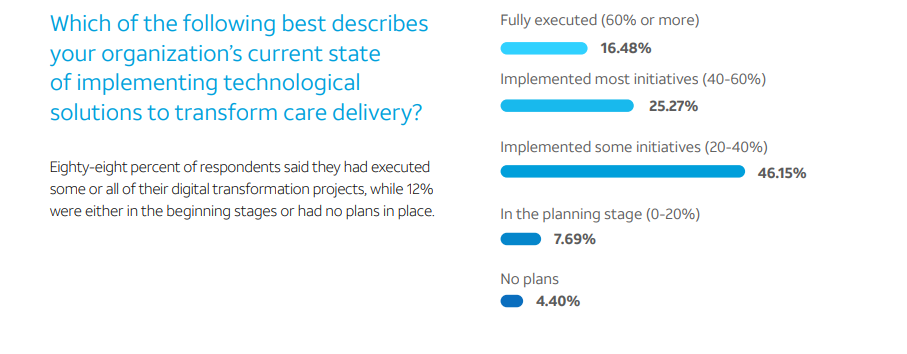
Improving care quality and patient experience are the major drivers
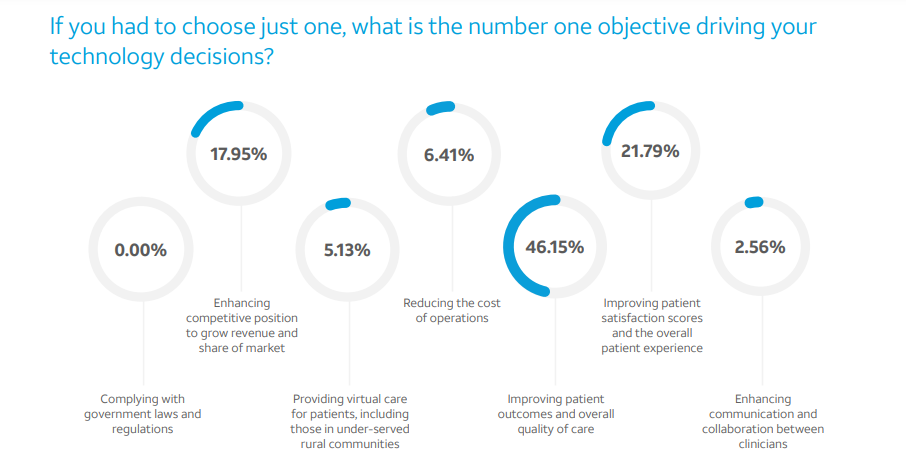
Industry executives are generally pleased with the results of their efforts
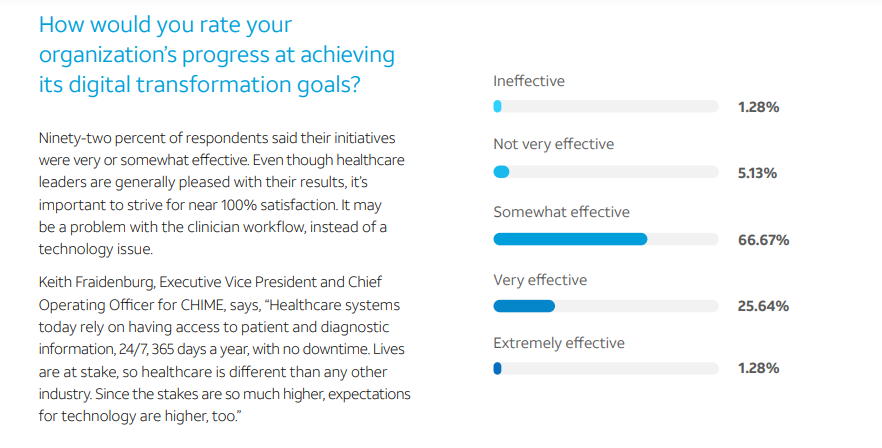
But challenges still exist that could jeopardize further progress
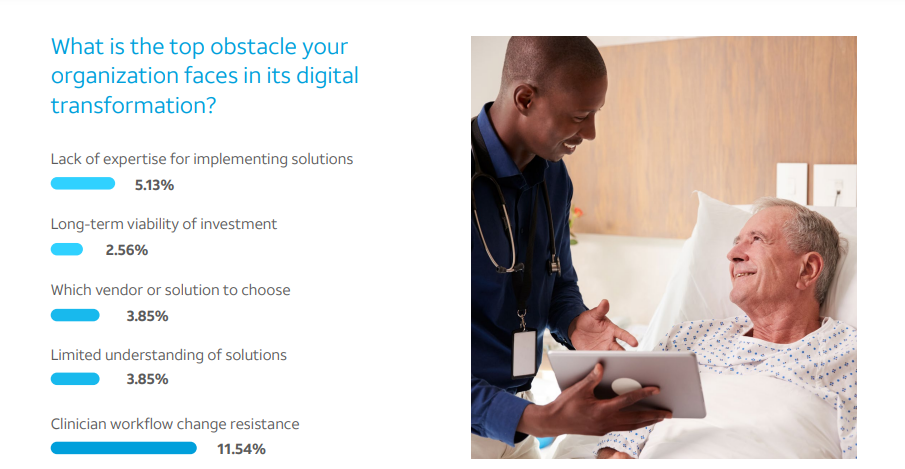
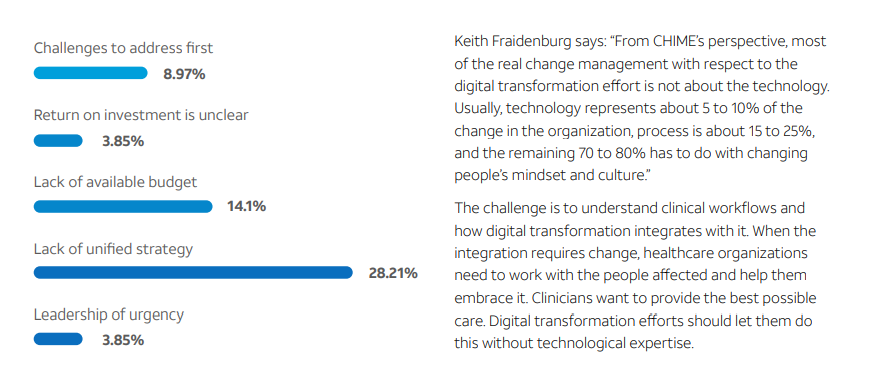
Improving the patient experience with technology is proving to be difficult — and executives are looking for help from 5G
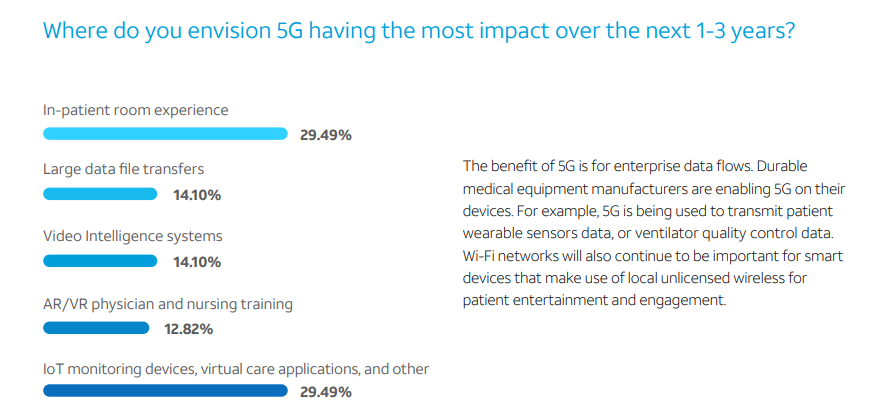
Virtual care remains a top priority moving forward
The benefit of 5G is for enterprise data flows. Durable medical equipment manufacturers are enabling 5G on their devices.
For example, 5G is being used to transmit patient wearable sensors data, or ventilator quality control data.
Wi-Fi networks will also continue to be important for smart devices that make use of local unlicensed wireless for patient entertainment and engagement.
Survey respondents were also interested in artificial or augmented intelligence as a top priority.
With artificial intelligence, a physician can analyze vast volumes of data to help with a difficult diagnosis.
ORIGINAL PUBLICATION (excerpt)

Digital transformation in healthcare: Survey analysis [Executive Summary]
AT&T Business
2022
Executive summary
Key questions every healthcare organization must ask themselves: “How healthy are our networks and tech systems, and how well are we progressing with our digital transformation initiatives?”
Many of us started the digital transformation in a rush. With the onset of the COVID-19 pandemic in the spring of 2020, there was no other choice.
Now organizations are taking a breath, revising hurried decisions, and planning their next steps.
Many of us started the digital transformation in a rush. With the onset of the COVID-19 pandemic in the spring of 2020, there was no other choice.
Now organizations are taking a breath, revising hurried decisions, and planning their next steps.
Digital transformation has the potential to improve overall patient care.
With that as the motivation, organizations need an enterprise design strategy to replace quickly implemented point solutions. This involves planning.
Digital transformation has the potential to improve overall patient care.
With that as the motivation, organizations need an enterprise design strategy to replace quickly implemented point solutions. This involves planning.
Before diving into unfamiliar territory, it’s good to find out what others are doing.
With this goal in mind, a recent survey conducted by the College of Healthcare Information Management Executives (CHIME) for AT&T Business, asked key players in healthcare — decision makers and IT professionals — a series of questions.
Metaphorically, we did a CAT scan on the industry and how well it’s adopting and adapting to cutting-edge technology.
At AT&T Business, we’re bringing you this report to share the status of the digital transformation in the healthcare industry, what’s driving the transformation, how satisfied leaders are with their transformation progress, challenges that could jeopardize that progress, top priorities for the future, technology complications that affect the patient experience, and finally, recommendations for improving your digital transformation.
The survey indicates that healthcare organizations should carefully choose their top digital transformation priorities and, where appropriate, take advantage of 5G and cloud technology, as well as managed networking opportunities.
The insights in this report serve as a benchmark to help you evaluate where you are and your next step forward.
The survey indicates that healthcare organizations should carefully choose their top digital transformation priorities and, where appropriate, take advantage of 5G and cloud technology, as well as managed networking opportunities.
Key insights
- Digital transformation in the industry is well underway: 89% of respondents said they had fully executed some or all of their digital transformation projects.
- Improving care quality and patient experience are the major drivers: 46% said improving patient outcomes and overall quality of care was the №1 objective.
- Industry executives are generally pleased with the results of their efforts: 92% of their initiatives were very or somewhat effective.
- Challenges still exist that could jeopardize further progress: 28% said a lack of unified vision or strategy in their organizations was the top challenge that affects the patient experience.
- Improving the patient experience with technology is proving to be difficult — and executives are looking for help from 5G: 34% said improving the patient and guest experience is the challenge they are struggling the most to solve with technology, and 30% said 5G will have the biggest impact on in-facility patient experience over the next 1–3 years.
- Virtual care remains a top priority moving forward: 22% said they were most interested in telehealth and remote patient monitoring solutions over the next 1–3 years.
a lack of unified vision or strategy in their organizations was the top challenge that affects the patient experience.
Conclusion
From a network communications perspective, the top priority for healthcare organizations is to refine and optimize the solutions quickly implemented due to the pandemic and develop them into an enterprise-wide strategy.
The goal is an enterprise design with cohesive IT solutions that make sense in terms of the organization’s infrastructure.
Mobile networks are now built for enterprise data flows, and technology such as 5G and cloud services are available.
With this technology, we can move towards more equitable healthcare by bringing remote patient monitoring and telehealth to rural and less-affluent urban areas.
Healthcare organizations are moving towards managed services so that IT has the time to focus on digital transformation goals.
With managed services, the day-today voice, data, network, and security operations work is no longer part of the IT workday, allowing time to focus on problems related to their organization.
Finally, with the advent of telehealth and remote patient monitoring, clinicians can easily share data and communicate with patients.
And by catching health issues early, technology is helping patients avoid hospital stays.
Ultimately, digital transformation moves healthcare organizations towards their primary goal — improving quality of care and the patient experience.

APPENDIX 1: Presentation Letter
Dear friends,
Perhaps no other industry has been as severely impacted by COVID-19 as healthcare. The pandemic caused a significant disruption to the industry’s clinical and business operations and greatly accelerated the adoption of technology across the continuum of care.
By investing in digital technologies, healthcare organizations can enhance communication and collaboration among caregivers, improve the overall patient experience, and efficiently deliver care to patients outside traditional healthcare facilities. While many organizations understand the need to blend physical capabilities with digital technologies, the constant evolution of technology makes choices more complicated. How can you be sure that your digital solutions will work for your specific clinical and operational needs?
At AT&T Business, we’re invested in helping you efficiently deliver the best care for your patients. We are always here for you — ready to provide support when you need it and making sure you stay connected. No matter what lies ahead, we make your success a priority by remaining alert and responsive and by anticipating your business needs. That’s why we’ve partnered with the College of Healthcare Information Management Executives (CHIME) to survey its members on the state of digital transformation in healthcare.
Through this report, you will learn how C-suite leaders at healthcare organizations across the country view the state of their digital transformation and their top priorities and challenges for the months and years ahead.
We hope this resource provides additional insights to help make your digital transformation journey successful.
— Joe Drygas, VP, Industry Solutions Healthcare, AT&T Business

APPENDIX 2: About the respondents
We surveyed senior healthcare IT leaders from the College of Healthcare Information Management Executives (CHIME) and other affiliated organizations to generate the results featured in this report. The majority of respondents (94%) are from CHIME, a professional organization for Chief Information Officers and other senior healthcare IT leaders.
Six percent of the respondents are members of nonprofit professional associations that CHIME manages, including the Association for Executives in Healthcare Information Security (AEHIS), Association for Executives in Healthcare Information Technology (AEHIT), and the Association for Executives in Healthcare Information Applications (AEHIA). Members of these associations include information security, technology, and applications leaders who influence health investment and technology decisions.
Which of the following best describes your organization?
The respondents also represented hospital systems of varying sizes. Of 91 respondents, 65% represented large multi-hospital systems and Integrated Delivery Networks
What is the size of your organization?
Forty-five percent represented healthcare systems with greater than 500 beds.
Originally published at: https://www.business.att.com
Names mentioned:
Joe Drygas, VP, Industry Solutions Healthcare, AT&T Business
College of Healthcare Information Management Executives (CHIME)
Keith Fraidenburg, Executive Vice President and Chief Operating Officer for CHIME












